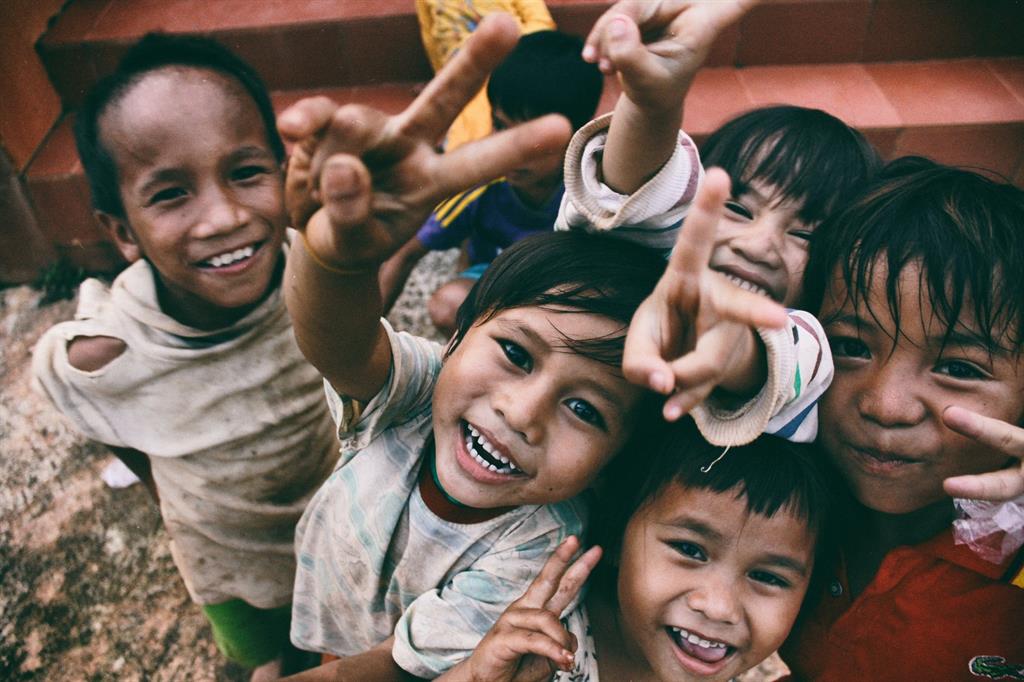Children: improving survival and well-being
In 2019 an estimated 5.2 million children under 5 years died mostly from preventable and treatable causes.
Children aged 1 to 11 months accounted for 1.5 million of these deaths while children aged 1 to 4 years accounted for 1.3 million deaths. Newborns (under 28 days) accounted for the remaining 2.4 million deaths.
An additional 500 000 older children (5 to 9 years) died in 2019.
Leading causes of death in children under-5 years are preterm birth complications, birth asphyxia/trauma, pneumonia, congenital anomalies, diarrhoea and malaria, all of which can be prevented or treated with access to simple, affordable interventions including immunisation, adequate nutrition, safe water and food and quality care by a trained health provider when needed.
Older children (5-9 years) had one of the largest declines in mortality since 1990 (61%), due to a decline in infectious diseases. Injuries (including road traffic injuries and drowning) are the leading causes of death among older children.
Who is most at risk?
Children under the age of 5
Substantial global progress has been made in reducing child deaths since 1990. The total number of under-5 deaths worldwide has declined from 12.6 million in 1990 to 5.2 million in 2019. Since 1990, the global under-5 mortality rate has dropped by 59%, from 93 deaths per 1 000 live births in 1990 to 38 in 2019. This is equivalent to 1 in 11 children dying before reaching age 5 in 1990, compared to 1 in 27 in 2019.
Although the world as a whole has been accelerating progress in reducing the under-5 mortality rate, difference exist in under-5 mortality across regions and countries.
Regions
Sub-Saharan Africa remains the region with the highest under-5 mortality rate in the world, with 1 child in 13 dying before his or her fifth birthday, 20 years behind the world average which achieved a 1 in 13 rate in 1999. Two regions, Sub-Saharan Africa and Central and Southern Asia, account for more than 80% of the 5.2 million under-five deaths in 2019, while they only account for 52% of the global under-five population. Half of all under-five deaths in 2019 occurred in just five countries: Nigeria, India, Pakistan, the Democratic Republic of the Congo and Ethiopia. Nigeria and India alone account for almost a third of all deaths.
At the country level, mortality rates for older children ranged from 0.2 to 16.8 deaths per 1 000 children aged 5 years. As for children under five, higher mortality countries are concentrated in sub-Saharan Africa. Countries with the highest number of deaths for 5 to 9-year-olds include India, Nigeria, Democratic Republic of the Congo, Pakistan and China.
Globally
Globally, infectious diseases, including pneumonia, diarrhoea and malaria, along with pre-term birth, birth asphyxia and trauma, and congenital anomalies remain the leading causes of death for children under five. Access to basic lifesaving interventions such as skilled delivery at birth, postnatal care, breastfeeding and adequate nutrition, vaccinations, and treatment for common childhood diseases can save many young lives.
Malnourished children, particularly those with severe acute malnutrition, have a higher risk of death from common childhood illness such as diarrhoea, pneumonia, and malaria. Nutrition-related factors contribute to about 45% of deaths in children under-5 years of age.
Patterns
The patterns of death in older children reflect the underlying risk profiles of this age group, with a shift away from infectious diseases of childhood and towards accidents and injuries, notably drowning and road traffic injuries. The rise of injury deaths changes the nature of interventions to improve older child survival. There is a shift from health sector actions to prevent and treat the infectious diseases of early childhood towards other government sectors including education, transportation and road infrastructure, water and sanitation and law enforcement. All of these need to work together to prevent premature mortality in older children.
Global response: Sustainable Development Goal 3.2.1
The Sustainable Development Goals (SDGs) adopted by the United Nations in 2015 were developed to promote healthy lives and well-being for all children. The SDG Goal 3.2.1 is to end preventable deaths of newborns and under-5 children by 2030. There are two targets:
*Reduce newborn mortality to at least as low as 12 per 1 000 live births in every country; and
*Reduce under-five mortality to at least as low as 25 per 1 000 live births in every country.
Target 3.2.1 is closely linked with target 3.1.1, to reduce the global maternal mortality ratio to less than 70 deaths per 100 000 live births, and target 2.2.1 on ending all forms of malnutrition, as malnutrition is a frequent cause of death for under-5 children.
These have been translated into the new "Global Strategy for Women’s, Children’s and Adolescent’s Health" (Global Strategy), which calls for ending preventable child deaths while addressing emerging child health priorities.
In 2019, 122 countries have met the SDG target for under-5 mortality and a further 20 countries are expected to meet the target by 2030 if current trends continue.
However, accelerated progress will be needed in 53 countries, which will not achieve the target by 2030 on current trends. Thirty of these countries will need to double their current rate of reduction and 23 will need to triple their current rate of reduction.
Meeting the SDG target would reduce the number of under-5 deaths by 11 million between 2019 and 2030. Focused efforts are still needed in Sub-Saharan Africa and South East Asia to prevent 80% of these deaths.
Source: WHO
An additional 500 000 older children (5 to 9 years) died in 2019.
Leading causes of death in children under-5 years are preterm birth complications, birth asphyxia/trauma, pneumonia, congenital anomalies, diarrhoea and malaria, all of which can be prevented or treated with access to simple, affordable interventions including immunisation, adequate nutrition, safe water and food and quality care by a trained health provider when needed.
Older children (5-9 years) had one of the largest declines in mortality since 1990 (61%), due to a decline in infectious diseases. Injuries (including road traffic injuries and drowning) are the leading causes of death among older children.
Who is most at risk?
Children under the age of 5
Substantial global progress has been made in reducing child deaths since 1990. The total number of under-5 deaths worldwide has declined from 12.6 million in 1990 to 5.2 million in 2019. Since 1990, the global under-5 mortality rate has dropped by 59%, from 93 deaths per 1 000 live births in 1990 to 38 in 2019. This is equivalent to 1 in 11 children dying before reaching age 5 in 1990, compared to 1 in 27 in 2019.
Although the world as a whole has been accelerating progress in reducing the under-5 mortality rate, difference exist in under-5 mortality across regions and countries.
Regions
Sub-Saharan Africa remains the region with the highest under-5 mortality rate in the world, with 1 child in 13 dying before his or her fifth birthday, 20 years behind the world average which achieved a 1 in 13 rate in 1999. Two regions, Sub-Saharan Africa and Central and Southern Asia, account for more than 80% of the 5.2 million under-five deaths in 2019, while they only account for 52% of the global under-five population. Half of all under-five deaths in 2019 occurred in just five countries: Nigeria, India, Pakistan, the Democratic Republic of the Congo and Ethiopia. Nigeria and India alone account for almost a third of all deaths.
At the country level, mortality rates for older children ranged from 0.2 to 16.8 deaths per 1 000 children aged 5 years. As for children under five, higher mortality countries are concentrated in sub-Saharan Africa. Countries with the highest number of deaths for 5 to 9-year-olds include India, Nigeria, Democratic Republic of the Congo, Pakistan and China.
Globally
Globally, infectious diseases, including pneumonia, diarrhoea and malaria, along with pre-term birth, birth asphyxia and trauma, and congenital anomalies remain the leading causes of death for children under five. Access to basic lifesaving interventions such as skilled delivery at birth, postnatal care, breastfeeding and adequate nutrition, vaccinations, and treatment for common childhood diseases can save many young lives.
Malnourished children, particularly those with severe acute malnutrition, have a higher risk of death from common childhood illness such as diarrhoea, pneumonia, and malaria. Nutrition-related factors contribute to about 45% of deaths in children under-5 years of age.
Patterns
The patterns of death in older children reflect the underlying risk profiles of this age group, with a shift away from infectious diseases of childhood and towards accidents and injuries, notably drowning and road traffic injuries. The rise of injury deaths changes the nature of interventions to improve older child survival. There is a shift from health sector actions to prevent and treat the infectious diseases of early childhood towards other government sectors including education, transportation and road infrastructure, water and sanitation and law enforcement. All of these need to work together to prevent premature mortality in older children.
Global response: Sustainable Development Goal 3.2.1
The Sustainable Development Goals (SDGs) adopted by the United Nations in 2015 were developed to promote healthy lives and well-being for all children. The SDG Goal 3.2.1 is to end preventable deaths of newborns and under-5 children by 2030. There are two targets:
*Reduce newborn mortality to at least as low as 12 per 1 000 live births in every country; and
*Reduce under-five mortality to at least as low as 25 per 1 000 live births in every country.
Target 3.2.1 is closely linked with target 3.1.1, to reduce the global maternal mortality ratio to less than 70 deaths per 100 000 live births, and target 2.2.1 on ending all forms of malnutrition, as malnutrition is a frequent cause of death for under-5 children.
These have been translated into the new "Global Strategy for Women’s, Children’s and Adolescent’s Health" (Global Strategy), which calls for ending preventable child deaths while addressing emerging child health priorities.
In 2019, 122 countries have met the SDG target for under-5 mortality and a further 20 countries are expected to meet the target by 2030 if current trends continue.
However, accelerated progress will be needed in 53 countries, which will not achieve the target by 2030 on current trends. Thirty of these countries will need to double their current rate of reduction and 23 will need to triple their current rate of reduction.
Meeting the SDG target would reduce the number of under-5 deaths by 11 million between 2019 and 2030. Focused efforts are still needed in Sub-Saharan Africa and South East Asia to prevent 80% of these deaths.
Source: WHO









Comments
Namibian Sun
No comments have been left on this article